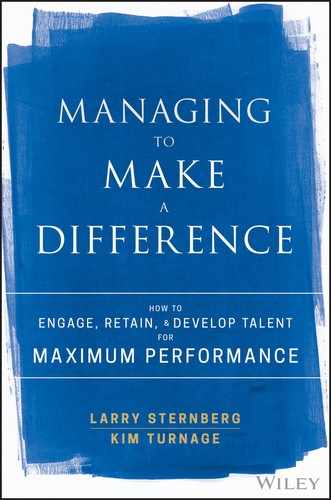Chapter 17
Set the Right Expectations
You are cultivating positive relationships with your people, discovering their unique talents and strengths, optimizing the fit between their themes and their responsibilities, and working on becoming a better coach to each person on your team. What else can you do to unleash outstanding performance in the people and teams you manage? Set high expectations for their performance, make sure they are the right expectations, and communicate them in the right way. We will start with a story about how to communicate your expectations.
The expectations of an authority figure have powerful consequences. This phenomenon, known as the Pygmalion effect, has been thoroughly researched, beginning with Rosenthal and Jacobson's seminal study of elementary teachers and students in the 1960s1 and continuing into J. Sterling Livingston's research as a management consultant and faculty member of the Harvard Business School.2 The findings are remarkable and consistent whether you look at students or employees: People will live up or down to the expectations of their leader.
High expectations can drive individual growth and development. But they must be the right high expectations. They can't just be the “pie in the sky” kind. They should align with people's themes. You should not ask a person to change who they are or to achieve excellence in an area in which they do not have the appropriate themes. For example, expecting an intensely introverted person to perform with excellence in a job that requires consistent extroverted behavior is not the right expectation. But it would be the right expectation if you are dealing with an extroverted person. In the same way, your expectations for performance need to be realistic, precise, and measurable so people can know what you expect, what success looks like, and when they have hit the mark.
Here is another story about how the right high expectations created surprising success:
Certainly, the credit goes to Marie. But it would not have happened without a manager who recognized her potential, truly believed in her ability, and placed clear expectations for her to live up to that potential.
Placing the right expectations can be one of your most satisfying activities as a leader.
Your expectations create the opportunity for people to see new possibilities. They can motivate people to achieve things they never even imagined. When you believe in your heart of hearts that people can do something, they will believe it, too. When you get this right, magic really does occur. When you do not, the Pygmalion effect can work just as strongly against success as it does for success. Remember: People will live up or down to the expectations of their leader.
So far, we have focused on the “living up” part of that idea. Beware of the “living down” part. So much of what makes the Pygmalion effect work happens in your unconscious actions.
Your expectations are communicated in a thousand ways, including tone of voice, body language, choice of words, and facial expressions. Here are some specific ways teachers, coaches, and managers might unintentionally and unconsciously act differently when they have high expectations for people to succeed:3
- They create a warmer socioemotional climate through gestures as simple as a nod of the head, an encouraging smile, or a touch on the shoulder.
- Because they have high expectations, they teach people more and provide more challenging lessons.
- They provide more opportunities for people to contribute and provide more time for such contributions.
- They provide personalized feedback, not just a generic pat on the back.
Those nods of the head, encouraging smiles, and touches on the shoulder encourage people to live up to your expectations—and those actions speak louder than words. But those unconscious actions only happen when you really believe people can achieve the high expectations you set for them. If, in your heart of hearts, you believe people will fail, you cannot help but behave in ways that will communicate that expectation. Those encouraging nods and smiles and pats on the back will not happen. In fact, when you believe people cannot succeed, you are prone to withdrawing and limiting your interactions with them. Silence and indifference shout that your expectations are low and you believe investments in people will yield low returns. When you really believe people cannot succeed, people will know it, and they will live down to your expectations.
One final thought. Think about the people who have contributed to your growth and development. Did they articulate expectations? Did they ask you to live up to your potential? How did their expectations influence your performance and growth?
